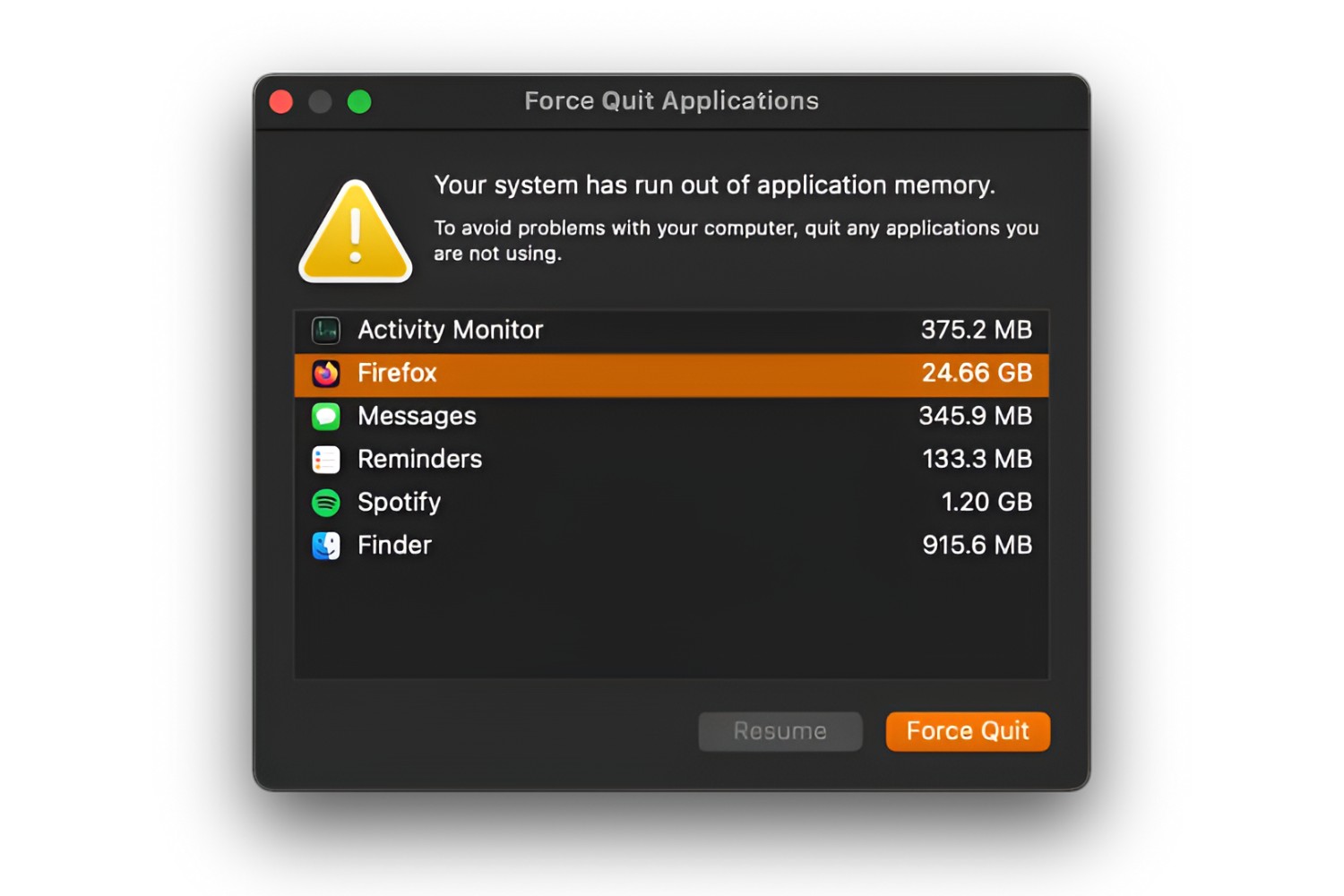Introduction
Have you ever experienced the frustration of a frozen or unresponsive Firefox browser? It's a common occurrence that can disrupt your workflow and leave you feeling helpless. When Firefox becomes unresponsive, it can be challenging to close it using the conventional methods. However, there are several effective techniques you can employ to force close Firefox and regain control of your browsing experience.
In this article, we will explore three methods to force close Firefox when it becomes unresponsive. Whether you're a seasoned tech enthusiast or a casual user, these methods will equip you with the knowledge to tackle this common issue. From using the Task Manager to leveraging Firefox's built-in tools, we'll cover a range of approaches to help you navigate through unresponsive browser situations with ease.
So, if you've ever found yourself staring at an unresponsive Firefox window, feeling perplexed about how to regain control, fear not. By the end of this article, you'll be armed with the know-how to swiftly and effectively force close Firefox, allowing you to resume your browsing activities without unnecessary delays or frustrations. Let's dive into the methods and empower ourselves with the tools to conquer unresponsive Firefox instances.
Method 1: Using Task Manager
When Firefox becomes unresponsive, using the Task Manager can be a reliable way to force close the browser and regain control of your system. The Task Manager is a powerful tool that allows you to view and manage the processes running on your computer, including unresponsive applications like Firefox. Here's how you can use the Task Manager to force close Firefox:
-
Accessing the Task Manager: To open the Task Manager, you can use the keyboard shortcut "Ctrl + Shift + Esc" or "Ctrl + Alt + Delete" and then select "Task Manager" from the options. Alternatively, you can right-click on the taskbar and choose "Task Manager" from the context menu.
-
Locating Firefox Processes: Once the Task Manager is open, navigate to the "Processes" tab. Here, you'll find a list of all the processes currently running on your system. Look for any entries related to Firefox. You may see multiple processes associated with Firefox, such as tabs, extensions, or plugins.
-
Ending Firefox Processes: Select the unresponsive Firefox processes by clicking on them, and then click the "End Task" button. This action will terminate the selected processes, effectively force closing Firefox.
-
Confirming the Closure: After ending the Firefox processes, you can close the Task Manager and attempt to relaunch Firefox. In most cases, the browser should open normally, allowing you to resume your browsing activities without any lingering issues.
Using the Task Manager to force close Firefox is a straightforward and effective method to address unresponsive browser instances. By terminating the problematic processes, you can swiftly regain control of your browsing experience and prevent further disruptions to your workflow.
In situations where Firefox becomes unresponsive and traditional methods fail to close the browser, the Task Manager serves as a reliable fallback, providing a means to take back control and restore normalcy to your browsing activities. Whether you're a tech-savvy user or a novice, mastering the use of the Task Manager can empower you to navigate through unresponsive browser scenarios with confidence and ease.
Method 2: Using Command Prompt
When faced with an unresponsive Firefox browser, utilizing the Command Prompt can provide an alternative approach to force close the application. The Command Prompt, also known as cmd.exe or cmd, is a powerful tool in Windows that allows users to interact with the operating system through text-based commands. Here's how you can leverage the Command Prompt to force close Firefox:
-
Accessing the Command Prompt: To open the Command Prompt, you can use the keyboard shortcut "Windows Key + R" to open the "Run" dialog, then type "cmd" and press Enter. Alternatively, you can search for "Command Prompt" in the Windows search bar and launch the application.
-
Identifying Firefox Processes: Once the Command Prompt is open, you can use a command called "tasklist" to view a list of all the running processes on your system. To specifically identify Firefox processes, you can use the command "tasklist | findstr firefox" to filter the results and display only the processes related to Firefox.
-
Terminating Firefox Processes: After identifying the Firefox processes, you can proceed to force close them using the "taskkill" command. By executing "taskkill /F /IM firefox.exe", you can forcefully terminate the Firefox processes, effectively closing the unresponsive browser.
-
Confirmation and Relaunch: Following the termination of Firefox processes, you can close the Command Prompt and attempt to relaunch Firefox. In most cases, the browser should open without any lingering issues, allowing you to resume your browsing activities seamlessly.
Utilizing the Command Prompt to force close Firefox provides a command-line approach to managing unresponsive applications. While it may seem more technical than using the Task Manager, it offers a precise method to identify and terminate specific processes related to Firefox, potentially resolving unresponsiveness more effectively.
By mastering the use of the Command Prompt, users can expand their troubleshooting capabilities and gain a deeper understanding of the underlying processes running on their system. This method empowers users with a command-line solution to address unresponsive Firefox instances, offering an additional tool in their arsenal to navigate through technical challenges with confidence.
Method 3: Using Firefox's built-in Task Manager
When encountering an unresponsive Firefox browser, leveraging the browser's built-in Task Manager can offer a convenient and effective approach to address the issue without relying on external tools or commands. Firefox's Task Manager provides users with a comprehensive view of browser processes and allows for the selective termination of specific elements contributing to unresponsiveness. Here's a detailed exploration of how to utilize Firefox's built-in Task Manager to force close the browser and regain control of your browsing experience.
-
Accessing Firefox's Task Manager: To open Firefox's Task Manager, you can use the keyboard shortcut "Shift + Esc" while the Firefox browser window is active. Alternatively, you can access it by clicking on the Firefox menu (three horizontal lines) in the top-right corner of the browser window, selecting "More Tools," and then choosing "Task Manager" from the submenu. Upon opening the Task Manager, you'll be presented with a list of active processes and their respective resource usage.
-
Identifying Unresponsive Processes: Within Firefox's Task Manager, you can identify processes that may be contributing to the browser's unresponsiveness. This includes individual tabs, extensions, plugins, and other browser-related elements. Unresponsive processes are often indicated by high resource usage or unchanging status, signaling a potential issue that warrants termination.
-
Terminating Unresponsive Processes: Once you've identified the processes causing the unresponsiveness, you can selectively terminate them by clicking on the specific process and then clicking the "End Process" button. This action effectively closes the problematic process, allowing you to address the unresponsiveness without affecting the entire browser session.
-
Confirmation and Continued Browsing: After terminating the unresponsive processes, you can close the Firefox Task Manager and proceed to relaunch Firefox. In most cases, the browser should open without any lingering issues, enabling you to resume your browsing activities seamlessly.
Utilizing Firefox's built-in Task Manager to force close the browser offers a user-friendly and intuitive method to address unresponsive instances without the need for external tools or complex commands. By providing a visual representation of browser processes and resource usage, the Task Manager empowers users to pinpoint and resolve unresponsiveness with precision, ultimately enhancing the browsing experience.
Mastering the use of Firefox's Task Manager equips users with a valuable tool to navigate through unresponsive browser scenarios, fostering a deeper understanding of browser processes and resource management. Whether you're a casual user or a tech enthusiast, leveraging Firefox's built-in Task Manager can streamline the process of addressing unresponsiveness, allowing you to maintain control and efficiency in your browsing activities.
Conclusion
In the realm of browsing experiences, encountering an unresponsive Firefox browser can be a frustrating and disruptive experience. However, armed with the knowledge and techniques explored in this article, users can confidently navigate through unresponsive instances and regain control of their browsing activities. Whether it's leveraging the Task Manager, utilizing the Command Prompt, or harnessing Firefox's built-in Task Manager, each method offers a unique approach to force close Firefox and address unresponsiveness effectively.
The Task Manager serves as a reliable ally, providing users with a straightforward and accessible means to terminate unresponsive Firefox processes. Its intuitive interface and familiar functionality make it a go-to solution for users seeking a quick and effective method to regain control of their browsing experience. By mastering the use of the Task Manager, users can swiftly address unresponsive instances and resume their browsing activities without unnecessary delays.
For those inclined towards a more technical approach, the Command Prompt offers a command-line solution to identify and terminate specific Firefox processes contributing to unresponsiveness. While it may require a bit more familiarity with command-based interactions, it presents a precise method to address unresponsiveness and expand users' troubleshooting capabilities.
Furthermore, Firefox's built-in Task Manager stands out as a user-friendly and intuitive tool that empowers users to address unresponsiveness without relying on external resources. Its visual representation of browser processes and resource usage provides a comprehensive view, allowing users to pinpoint and terminate problematic elements with precision.
By exploring and mastering these methods, users can equip themselves with the tools to conquer unresponsive Firefox instances with confidence and ease. Whether it's a casual browsing session or a critical task at hand, the ability to swiftly address unresponsiveness can significantly enhance the overall browsing experience.
In conclusion, the diverse methods presented in this article offer users a range of options to tackle unresponsive Firefox instances, ensuring that they can navigate through technical challenges with resilience and efficiency. By incorporating these techniques into their troubleshooting repertoire, users can reclaim control of their browsing experience and maintain seamless productivity in the digital realm.

























